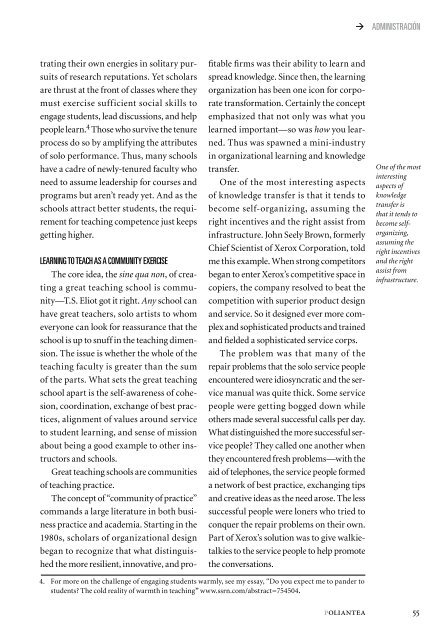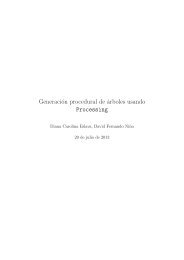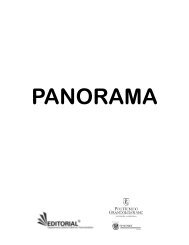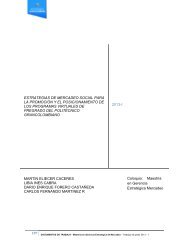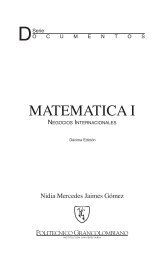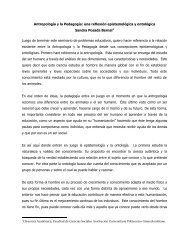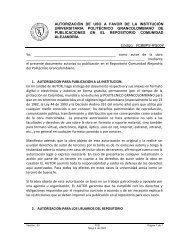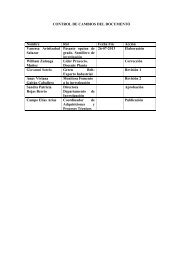Hell is other people.Jean Paul Sartre 1What life have you, if you have not life together?There is no life not lived in community.T.S. Eliot 2One of the great dilemmas in highermanagement education regards how aschool should organize its teaching activities.The dominant paradigm is to viewinstructors as solo artists who need onlyto affiliate themselves with other expertsin a discipline—this for administrativepurposes. The scholar teaches the way heor she does research, as a relatively independentactor. Under this paradigm, learningto teach is also a solo effort, producinga relatively wide variance in studentevaluations and satisfaction. Instructors,who don’t meet expected standards of teaching,are washed out. The toll in humancapital as instructors learn, by trial-anderror,can be large. The faculty was virtuallyinvisible: the faculty meeting was sparselyattended; most instructors worked athome; when on the premises, they workedbehind closed doors. Generally, they justRESEÑA DE AUTORRobert Bruner (BrunerR@virginia.edu). Is the dean ofthe Darden Graduate School of Business Administration atthe University of Virginia. He is also Darden’s DistinguishedProfessor of Business Administration. Bruner receivedhis B.A. from Yale University and his MBA and PHD fromHarvard Business School. Bruner is the co-author, alongwith Sean D. Carr, of The Panic of 1907: Lessons Learnedfrom the Market’s Perfect Storm. The book recounts theearly 20th century stock market collapse, known as ThePanic of 1907.showed up to teach and then departed.Junior faculty members were excitedabout their research. Senior faculty memberswere focused on teaching and administration.An alternate paradigm is to view the teachingtask as part of a community effort,requiring some coordination and collaboration,and at the very least, a pool in whichinstructors can learn their craft from eachother. It is less well-known. Since the dominantparadigm is well-known, the purposeof this note is to explore what it is to learn toteach under the alternate paradigm.Teaching as a community effortIn 2004, the U.S. Olympic Team inBasketball slunk home with the bronzemedal, having lost to Lithuania, PuertoRico, and Argentina. Previously the U.S.Olympic basketball team had lost only onegame in its history. Initially, the team hadbeen composed of NCAA stars. Then, whenthe going got tough, the U.S. got the ruleschanged so that NBA professionals couldbe qualified for the team. One observersaid, “Star for star, the basketball teamsfrom places like Lithuania or Puerto Ricostill don’t rank well versus the Americans,but when they play as a team—when theycollaborate better than we do—they areextremely competitive.” 3The late experience of the U.S. Olympicbasketball team is a metaphor for thechallenge facing many business schools.Academic appointments tend to attractloners, introverts who succeed at concen-54 poliantea1. Closed Doors (1944)2. Choruses from the Rock (1934)3. Quotation of Joel Conley in Thomas L. Friedman, The World is Flat, New York: Farrar Straus, and Giroux,2005, page 251.
‡ Administracióntrating their own energies in solitary pursuitsof research reputations. Yet scholarsare thrust at the front of classes where theymust exercise sufficient social skills toengage students, lead discussions, and helppeople learn. 4 Those who survive the tenureprocess do so by amplifying the attributesof solo performance. Thus, many schoolshave a cadre of newly-tenured faculty whoneed to assume leadership for courses andprograms but aren’t ready yet. And as theschools attract better students, the requirementfor teaching competence just keepsgetting higher.Learning to teach as a community exerciseThe core idea, the sine qua non, of creatinga great teaching school is community—T.S.Eliot got it right. Any school canhave great teachers, solo artists to whomeveryone can look for reassurance that theschool is up to snuff in the teaching dimension.The issue is whether the whole of theteaching faculty is greater than the sumof the parts. What sets the great teachingschool apart is the self-awareness of cohesion,coordination, exchange of best practices,alignment of values around serviceto student learning, and sense of missionabout being a good example to other instructorsand schools.Great teaching schools are communitiesof teaching practice.The concept of “community of practice”commands a large literature in both businesspractice and academia. Starting in the1980s, scholars of organizational designbegan to recognize that what distinguishedthe more resilient, innovative, and profitablefirms was their ability to learn andspread knowledge. Since then, the learningorganization has been one icon for corporatetransformation. Certainly the conceptemphasized that not only was what youlearned important—so was how you learned.Thus was spawned a mini-industryin organizational learning and knowledgetransfer.One of the most interesting aspectsof knowledge transfer is that it tends tobecome self-organizing, assuming theright incentives and the right assist frominfrastructure. John Seely Brown, formerlyChief Scientist of Xerox Corporation, toldme this example. When strong competitorsbegan to enter Xerox’s competitive space incopiers, the company resolved to beat thecompetition with superior product designand service. So it designed ever more complexand sophisticated products and trainedand fielded a sophisticated service corps.The problem was that many of therepair problems that the solo service peopleencountered were idiosyncratic and the servicemanual was quite thick. Some servicepeople were getting bogged down whileothers made several successful calls per day.What distinguished the more successful servicepeople? They called one another whenthey encountered fresh problems—with theaid of telephones, the service people formeda network of best practice, exchanging tipsand creative ideas as the need arose. The lesssuccessful people were loners who tried toconquer the repair problems on their own.Part of Xerox’s solution was to give walkietalkiesto the service people to help promotethe conversations.One of the mostinterestingaspects ofknowledgetransfer isthat it tends tobecome selforganizing,assuming theright incentivesand the rightassist frominfrastructure.4. For more on the challenge of engaging students warmly, see my essay, “Do you expect me to pander tostudents? The cold reality of warmth in teaching” www.ssrn.com/abstract=754504.poliantea 55
- Page 4 and 5: EditorialTendencias de la Educació
- Page 6 and 7: Los autores concluyen que los proce
- Page 8 and 9: Ana Mercedes HoyosArlina de los Cab
- Page 11 and 12: ‡ PSICOLOGÍAferente que a veces
- Page 13 and 14: ‡ PSICOLOGÍAque me dice qué pen
- Page 15 and 16: ‡ PSICOLOGÍAPeriplo Conceptual:
- Page 17 and 18: ‡ PSICOLOGÍAnos concentremos en
- Page 19 and 20: ‡ PSICOLOGÍAsituación; y el ran
- Page 21 and 22: ‡ PSICOLOGÍAlas razones para la
- Page 23 and 24: ‡ PSICOLOGÍApor su belleza (cóm
- Page 25 and 26: ‡ PSICOLOGÍAvos modos de ser. Se
- Page 27 and 28: ‡ AdministraciónADMINISTRACION D
- Page 29 and 30: ‡ Administraciónnistración de a
- Page 31 and 32: ‡ Administracióninversión en ac
- Page 33 and 34: ‡ AdministraciónEste ciclo en la
- Page 35 and 36: ‡ AdministraciónPOLÍTICAS EN LA
- Page 37 and 38: ‡ Administraciónde una obligaci
- Page 39 and 40: ‡ AdministraciónUn aumento de es
- Page 41 and 42: ‡ AdministraciónA medida que el
- Page 43 and 44: ‡ Administraciónlogro de la maxi
- Page 45 and 46: ‡ AdministraciónFinanciar requer
- Page 47 and 48: ‡ AdministraciónComo se citó an
- Page 49 and 50: ‡ AdministraciónRubros Enero Feb
- Page 51 and 52: ‡ AdministraciónLas necesidades
- Page 53: ‡ Administración“Leave me alon
- Page 57 and 58: ‡ Administraciónthe atmosphere,
- Page 59 and 60: ‡ Administraciónpoliantea 59
- Page 61 and 62: ‡ AdministraciónPrácticas de pr
- Page 63 and 64: ‡ Administracióntación de proye
- Page 65 and 66: ‡ Administracióntal, los resulta
- Page 67 and 68: ‡ Administración4. Prácticas de
- Page 69 and 70: ‡ AdministraciónAsimismo, los da
- Page 71 and 72: ‡ AdministraciónCuadro 9. Utiliz
- Page 73 and 74: ‡ Administraciónva desde el 4% h
- Page 75 and 76: ‡ AdministraciónSe encontró que
- Page 77 and 78: ‡ Administraciónpoliantea 77
- Page 79 and 80: ‡EDUCACIÓNENTRE EL CONSENSO Y EL
- Page 81 and 82: ‡EDUCACIÓNEn los lustros finales
- Page 83 and 84: ‡EDUCACIÓNpero que no son aprend
- Page 85 and 86: ‡EDUCACIÓNde asignaturas y con a
- Page 87 and 88: ‡EDUCACIÓNlas competencias. Sin
- Page 89 and 90: ‡EDUCACIÓNBajo este podemos incl
- Page 91 and 92: ‡EDUCACIÓNEs importante señalar
- Page 93 and 94: ‡EDUCACIÓNlos egresados y estudi
- Page 95 and 96: ‡EDUCACIÓNacciones académicas q
- Page 97 and 98: ‡ IngenierÍaRevisión del Métod
- Page 99 and 100: ‡ IngenierÍadesarrollan análisi
- Page 101 and 102: ‡ IngenierÍamarcan los períodos
- Page 103 and 104: ‡ IngenierÍael primer dato ajust
- Page 105 and 106:
‡ IngenierÍaPRONÓSTICOSIMPLETab
- Page 107 and 108:
‡ IngenierÍaLa formulación comp
- Page 109 and 110:
‡ IngenierÍadesde el punto de vi
- Page 111 and 112:
‡ IngenierÍaEl primer problema e
- Page 113 and 114:
‡ IngenierÍaClaramente se puede
- Page 115 and 116:
‡ IngenierÍaA partir de este an
- Page 117 and 118:
‡ IngenierÍa6.1. Prueba dosPara
- Page 119 and 120:
‡ IngenierÍaTabla 19.ÚltimaVari
- Page 121 and 122:
‡ IngenierÍaEl siguiente es el a
- Page 123 and 124:
‡ IngenierÍa6.3. Prueba cuatroPa
- Page 125 and 126:
‡ IngenierÍaPolinomial 320,00%15
- Page 127 and 128:
‡ IngenierÍa• Otra debilidad e
- Page 129 and 130:
‡ IngenierÍapoliantea 129
- Page 131 and 132:
‡ COMUNICACIÓNRedacción hiperte
- Page 133 and 134:
‡ COMUNICACIÓNcuatro caracterís
- Page 135 and 136:
‡ COMUNICACIÓNPara obtener los d
- Page 137 and 138:
‡ COMUNICACIÓNPeriódicopregunta
- Page 139 and 140:
‡ COMUNICACIÓN• PISCITELLI, Al
- Page 142 and 143:
En los discursos de la historia del
- Page 144 and 145:
El procesoestético deAna MercedesH
- Page 146 and 147:
la realidad cultural de su país. S
- Page 148 and 149:
de América, con lengua propia, que
- Page 150 and 151:
Ana Mercedes HoyosLa vara del premi
- Page 152 and 153:
pues ahora, por la gracia y poder d
- Page 154 and 155:
como un rugido, por poco nos deja s
- Page 156 and 157:
Unosesperaban quepor primeray únic
- Page 158 and 159:
Ana Mercedes HoyosPorcelana del med
- Page 160 and 161:
El que se siente(y sabe) apenasuna
- Page 162 and 163:
cializados: sobre todo en la biblio
- Page 164 and 165:
Es preciso quela biblioteca seesté
- Page 166 and 167:
Ana Mercedes HoyosPalenquera.La hum
- Page 168 and 169:
Boletín número 1S. E. llegó a es
- Page 170 and 171:
toración y que la materia morbífi
- Page 172 and 173:
ajosa. El vejigatorio ha purgado po
- Page 174 and 175:
El 17 dediciembrede 1830, alas cuat
- Page 176 and 177:
siderarse sino como causas secundar
- Page 178 and 179:
Ciertamenteel ser médicode cabecer
- Page 180 and 181:
Montilla, me dijo: «Ya que el Libe
- Page 182 and 183:
Después delos funeralesel generalM
- Page 184 and 185:
RESEÑASAna Mercedes HoyosSin títu
- Page 186 and 187:
Sin embargo, los perfectos retratos
- Page 188 and 189:
La obra se estructura como un manua
- Page 190 and 191:
ser, sino también la de sujeto. En
- Page 192 and 193:
Los detectives salvajesRoberto Bola
- Page 194 and 195:
La señora DallowayVirginia WolfMad
- Page 196 and 197:
Ana Mercedes HoyosSin títuloLa hum
- Page 198 and 199:
lidad al conjunto de reglas formale
- Page 200 and 201:
el ministerio intenta orientar con
- Page 202 and 203:
POLIANTEAInstrucciones para autores
- Page 204 and 205:
Presentación de ArtículosLos trab
- Page 206:
POLIANTEANOMBREAPELLIDOEDADLUGAR Y


